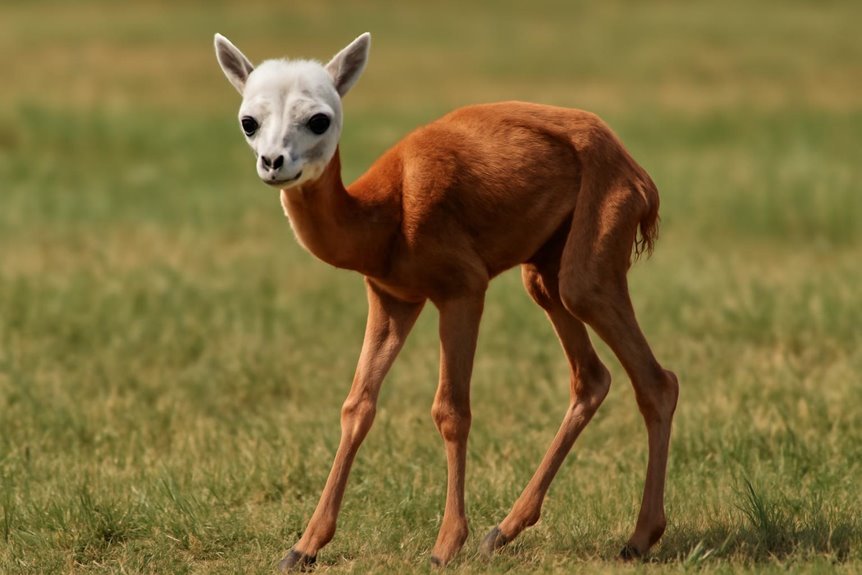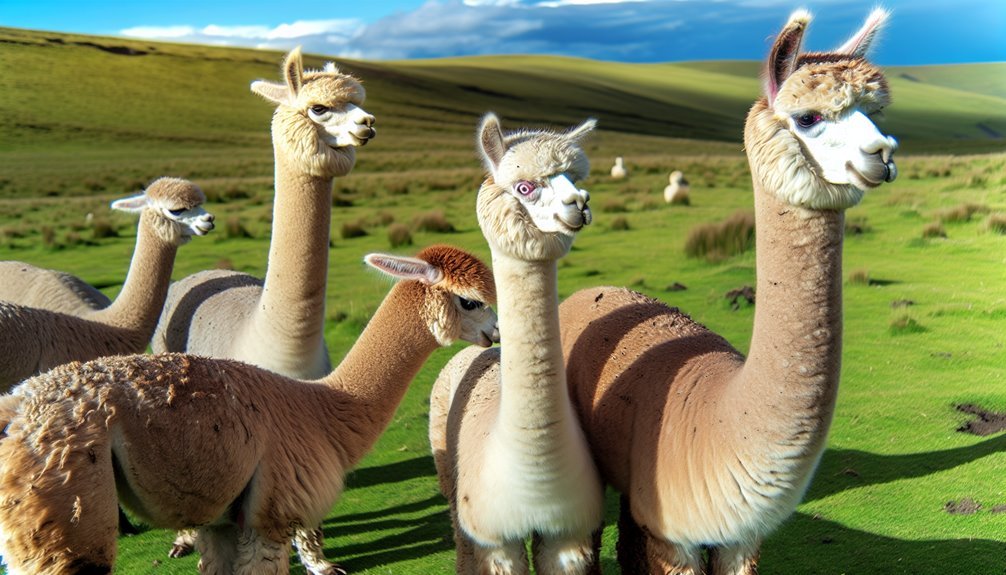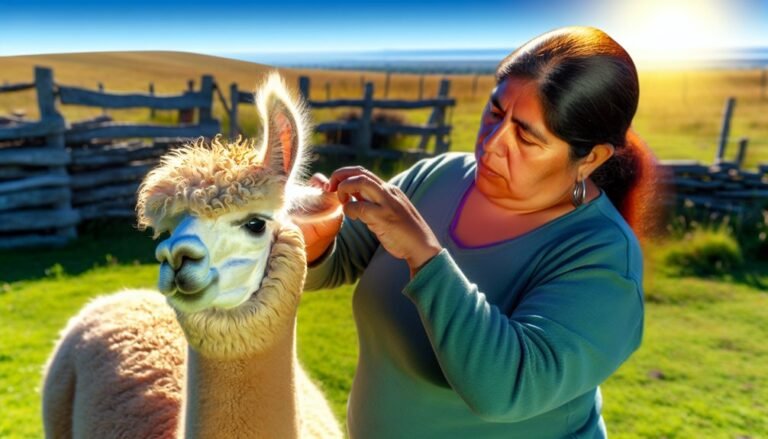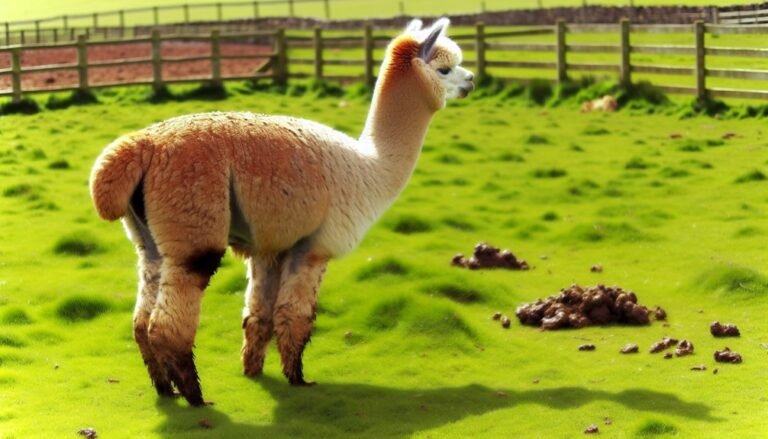7 Common Inherited Disorders Found in Alpacas
You’ll want to watch for seven common inherited disorders in alpacas: hereditary spinal muscular atrophy causing muscle weakness, choanal atresia which blocks nasal passages, maxillofacial dysgenesis or wry face affecting jaw alignment, congenital cardiac defects like ventricular septal defects, copper deficiency-related issues, zinc-responsive dermatosis, and genetic predispositions to respiratory conditions. These disorders can impact your herd’s health and breeding success. Keep exploring to understand how to identify and manage these challenges effectively.
Key Takeaways
- Hereditary spinal muscular atrophy causes progressive muscle weakness and atrophy in young alpacas due to a genetic mutation.
- Congenital cardiac defects, including ventricular septal defects and patent ductus arteriosus, lead to heart problems and exercise intolerance.
- Copper deficiency-related disorders result in fiber depigmentation, poor growth, and neurological issues like ataxia from inadequate copper levels.
- Choanal atresia causes nasal passage blockage, leading to severe respiratory distress and feeding difficulties at birth.
- Maxillofacial dysgenesis (wry face) causes jaw twisting, dental misalignment, and feeding problems, often necessitating exclusion from breeding.
Hereditary Spinal Muscular Atrophy

Although Hereditary Spinal Muscular Atrophy (SMA) is a serious genetic disorder in alpacas, understanding its causes can help you manage the risks. This hereditary spinal muscular atrophy results from a mutation in the survival motor neuron gene, causing progressive muscle weakness and atrophy. Affected individuals, usually young alpacas, struggle with standing, walking, and muscle loss. Since SMA is autosomally recessive, both parents must carry the mutated gene for offspring to be affected. Genetic testing is essential for identifying carriers and making informed breeding choices to reduce the risk of SMA. While there’s no cure, supportive care like physical therapy and nutritional support can help improve quality of life for affected alpacas. Knowing these facts empowers you to manage and prevent this challenging disorder effectively.
Choanal Atresia
Choanal atresia happens when your cria’s nasal passages are blocked, causing serious breathing problems right after birth. You’ll usually diagnose it with an exam plus imaging like endoscopy or X-rays. Treatment often means surgery, but keep in mind that affected crias shouldn’t be bred to prevent passing this inherited defect along.
Causes and Diagnosis
When a cria struggles to breathe right after birth, it could be due to a congenital blockage in the nasal passage known as choanal atresia. This inherited disorder causes an obstruction that may be unilateral or bilateral, leading to respiratory distress and difficulty suckling. Choanal atresia is one of the most common congenital defects in alpacas, often hereditary, so it’s important to avoid breeding affected animals to reduce recurrence. Diagnosis involves a thorough physical examination and visualization of the nasal passages, sometimes requiring imaging studies to confirm the obstruction’s extent. While surgical intervention may be needed to correct severe cases, understanding the cause and accurate diagnosis are essential first steps in managing choanal atresia and improving outcomes for affected crias.
Treatment and Prognosis
If your cria shows signs of respiratory distress due to a blocked nasal passage, prompt veterinary intervention is essential to evaluate the severity and plan treatment. Choanal atresia, a congenital defect causing nasal obstruction, often requires surgical correction to restore airflow. Early diagnosis is critical, as untreated crias may struggle with feeding and develop secondary complications. The prognosis depends on the defect’s extent and surgery success. With timely surgical correction and proper management, many crias can recover well and lead normal, healthy lives. Postoperative care includes monitoring breathing and ensuring adequate nutrition. Remember, ongoing management and follow-up veterinary care are crucial to address any issues early and support your cria’s long-term health after treatment.
Maxillofacial Dysgenesis (Wry Face)
You’ll notice maxillofacial dysgenesis, or wry face, by the distinct twisting of your alpaca’s upper jaw, which can make feeding and breathing tough. Unfortunately, treatment options are limited, and severe cases often have a poor prognosis. It’s essential to identify this condition early and avoid breeding affected animals to prevent passing it on.
Definition and Symptoms
Although maxillofacial dysgenesis, or wry face, is a congenital defect, you’ll notice it by the obvious lateral deviation of the alpaca’s maxilla that causes facial asymmetry. This inherited condition leads to clinical signs such as misaligned teeth and difficulty in suckling or chewing. These symptoms can severely impact the animal’s quality of life, making feeding and breathing challenging. The facial asymmetry is easily visible and often signals the presence of wry face. Since maxillofacial dysgenesis is inherited, affected alpacas should be excluded from breeding programs to prevent passing the defect to offspring. Recognizing these signs early helps in managing the condition and making informed decisions about the care and future breeding of the animal.
Treatment and Prognosis
Recognizing the signs of maxillofacial dysgenesis is just the first step; understanding how to manage the condition is equally important. After a thorough clinical examination, you’ll find that treatment options are quite limited due to the complex nature of this inherited disorder. Surgical correction is often not feasible and carries considerable risks. The prognosis largely depends on the severity of the deformity. Mild cases may allow your alpaca to maintain a reasonable quality of life, but severe cases can lead to serious complications, sometimes necessitating euthanasia. Since maxillofacial dysgenesis can considerably impact feeding and breathing, close monitoring is essential. Overall, managing this condition requires balancing the animal’s welfare with realistic treatment possibilities, given the challenges this inherited disorder presents.
Congenital Cardiac Defects
Several congenital cardiac defects, like ventricular septal defects (VSD) and patent ductus arteriosus (PDA), are common inherited issues in alpacas. You might notice affected animals showing exercise intolerance, lethargy, or abnormal heart sounds. Diagnosis typically involves echocardiography and clinical evaluation to confirm these congenital cardiac defects. While the exact hereditary component is still being studied, genetics likely play a role in their occurrence. Early detection is key since untreated severe defects can cause serious health problems. Management often includes supportive care to improve quality of life. In some cases, surgical intervention may be an option, but its availability is limited due to the need for specialized veterinary services. Staying vigilant for signs helps guarantee timely diagnosis and care.
Copper Deficiency-Related Disorders
When your alpaca doesn’t get enough copper, it can develop serious health problems like fiber depigmentation, weakened immunity, and increased infection risk. Copper deficiency affects immune function and can cause clinical signs such as poor growth rates and neurological symptoms like ataxia and weakness. Diagnosing copper deficiency often requires evaluating liver copper levels. To manage these health issues, you should focus on:
Copper deficiency in alpacas leads to fiber changes, immune weakness, and neurological issues requiring careful diagnosis and management.
- Careful supplementation to avoid toxicity
- Regular monitoring of copper status
- Tailored nutritional management based on region and individual needs
- Early detection of clinical signs for prompt intervention
- Preventing long-term neurological damage through proper care
Zinc-Responsive Dermatosis

Just as copper plays an important role in your alpaca’s health, zinc is another mineral you need to watch closely. Zinc-responsive dermatosis in alpacas is caused by zinc deficiency, leading to impaired immune function and making them more prone to infections. You’ll notice nonpruritic papules that progress to thickened crusts, mainly on the face and feet. Clinical observation is key for diagnosis, often confirmed by serum analysis or liver biopsies showing low zinc and copper levels. Treatment involves zinc supplementation through dietary adjustments or injections, alongside supportive care to manage skin lesions. To prevent this disorder, regular monitoring of zinc levels and proper dietary formulation are necessary, especially if your pasture has low zinc availability. Taking these steps helps maintain your alpacas’ health and well-being.
Genetic Predispositions to Respiratory Conditions
Although respiratory issues can arise from various causes, genetic predispositions play a significant role in your alpaca’s vulnerability to these conditions. Understanding these inherited factors helps you manage and reduce risks linked to respiratory health.
Key points to reflect upon include:
- Congenital anomalies like choanal atresia causing respiratory distress in crias
- Genetic influences on immune function increasing susceptibility to infectious diseases
- Higher incidence of chronic conditions such as pneumonia in certain bloodlines
- The impact of environmental factors combined with genetic predispositions
- Importance of selective breeding practices and ongoing health monitoring in herd management
Frequently Asked Questions
What Diseases Do Alpacas Carry?
You’ll encounter alpacas carrying genetic disorders tied to inherited traits, so focusing on disease prevention through smart breeding practices, veterinary care, nutrition impact, stress factors, and parasite management is essential for maintaining ideal alpaca health and managing common symptoms.
What Is the Mad Alpaca Disease?
When it comes to Mad Alpaca Disease, you can’t just sweep it under the rug. Watch for mad alpaca symptoms like aggression and disorientation. Genetic testing and good breeding practices are key, as treatment options are limited.
What Is the Silent Killer in Alpacas?
You should know the silent killer in alpacas often involves genetic predispositions masked by subtle early symptoms. Diagnostic tests help, but preventive measures like smart breeding, proper nutrition, stress reduction, and good herd management are essential for treatment options.
What Is Berserk Syndrome in Alpacas?
Berserk syndrome causes behavioral changes from poor socialization, not genetic predisposition. Symptoms of berserk include aggression and biting. Managing berserk syndrome relies on prevention strategies like early intervention and socialization techniques, though treatment options are limited, impacting owners considerably.








Our picks
Alpaca & Wool Felted Sole Inserts: Comfy Upgrade?
Best Alpaca Socks for Hiking: Ultimate Comfort and Durability on Trails
Best Alpaca Halter for Comfort and Control